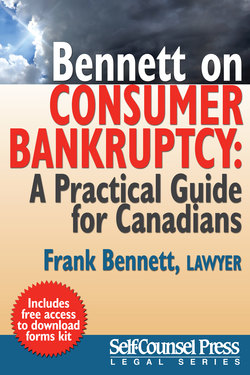Читать книгу Bennett on Consumer Bankruptcy - Frank Bennett - Страница 4
На сайте Литреса книга снята с продажи.
Chapter 1 What Is Bankruptcy?
ОглавлениеThis book offers a review of the bankruptcy process for individuals, primarily consumer debtors, who are in financial difficulty. This book does not review the bankruptcy process for small-business corporations. (Corporations cannot be consumers, but small-business persons may be able to take advantage of consumer bankruptcies and proposals; more on that later.) For readers who are interested in small corporate bankruptcies, see Bennett’s A–Z Guide to Bankruptcy: A Professional’s Handbook published by CCH Canadian Limited in Toronto.
In this chapter, the individual who may be facing bankruptcy can review the general outline of the bankruptcy process. It raises questions, the answers with which the consumer should consider before going into bankruptcy. Subsequent chapters expand each of the specific areas, and more. While bankruptcy is considered a last resort remedy for financial woes, the individual should first consider all remedies in dealing with debt including re-financing assets such as residential homes and condominiums; obtaining credit counselling; entering into some form of consolidation plan or order to pay something over time; making of a consumer proposal under the Bankruptcy and Insolvency Act to his or her creditors; or some other informal arrangement with his or her creditors. As a result of amendments to bankruptcy legislation over the last 20 years, these options can be more viable than going straight into bankruptcy.
Bankruptcy is for individuals who have significant debt. An individual shouldn’t necessarily consider bankruptcy for amounts under $100,000. First-time bankrupts get a “get out of jail free card” right away. Over a lifetime, they will not get the same concession if they file again. Repeat bankruptcy is on the rise with consumers and for individuals who may have some assets of value and for individuals who are self-employed, it is best to see a lawyer first before seeing a trustee in bankruptcy. While all lawyers have professional training and must be licensed by the Law Societies across Canada to practise, the individual should seek counsel from a lawyer who has experience in the bankruptcy and insolvency field. The initial or subsequent visit to review the individual’s financial affairs may lead one not to file for bankruptcy at all, but rather to negotiate some other settlement. In addition, the individual may have a valuable asset that may be lost in a bankruptcy. As will be discussed, the trustee in bankruptcy works for both the debtor and the creditors. The trustee is also an officer of the court and responsible to the court and to the Office of the Superintendent of Bankruptcy, the licensing body for trustees. Therefore, it is very difficult for a trustee to advise a debtor not to proceed with some form of insolvency protection when the individual is experiencing financial difficulties.
